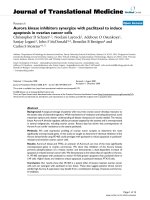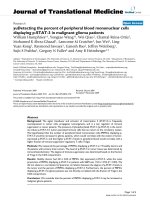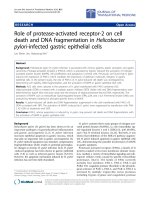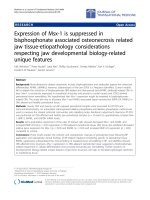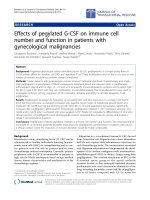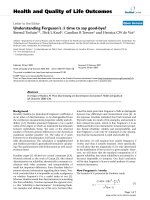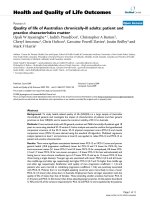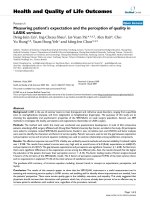báo cáo hóa học:" AIDS-associated Kaposi’s sarcoma is linked to advanced disease and high mortality in a primary care HIV programme in South Africa" pdf
Bạn đang xem bản rút gọn của tài liệu. Xem và tải ngay bản đầy đủ của tài liệu tại đây (369.55 KB, 5 trang )
SHORT REPOR T Open Access
AIDS-associated Kaposi’s sarcoma is linked to
advanced disease and high mortality in a primary
care HIV programme in South Africa
Kathryn M Chu
1*
, Gcina Mahlangeni
2
, Sarah Swannet
2
, Nathan P Ford
1,3
, Andrew Boulle
3
, Gilles Van Cutsem
2,3
Abstract
Background: AIDS-associated Kaposi’s sarcoma is an important, life-threatening opportunistic infection among
people living with HIV/AIDS in resource-limited settings. In western countries, the introduction of combination
antiretroviral therapy (cART) and new chemotherapeutic agents has resulted in decreased incidence and improved
prognosis of AIDS-associated Kaposi’s sarcoma. In African cohorts, however, mortality remains high. In this study,
we describe disease characteristics and risk factors for mortality in a public sector HIV programme in South Africa.
Methods: We analysed data from an observational cohort study of HIV-infected adults with AIDS-associated
Kaposi’s sarcoma, enrolled between May 2001 and January 2007 in three primary care clinics. Paper records from
primary care and tertiary hospital oncology clinics were reviewed to determine the site of Kaposi’s sarcoma lesions,
immune reconstitution inflammatory syndrome stage, and treatment. Baseline characteristics, cART use and survival
outcomes were extracted from an electronic database maintained for routine monitoring and evaluation. Cox
regression was used to model associations with mortality.
Results: Of 6292 patients, 215 (3.4%) had AIDS-associated Kaposi’s sarcoma. Lesions were most commonly oral
(65%) and on the lower extremities (56%). One quarter of patients did not receive cART. The mortality and lost-to-
follow-up rates were, respectively, 25 (95% CI 19-32) and eight (95% CI 5-13) per 100 person years for patients who
received cART, and 70 (95% CI 42-117) and 119 (80-176) per 100 person years for patients who did not receive
cART. Advanced T stage (adjusted HR, AHR = 5.3, p < 0.001), advanced S stage (AHR = 5.1, p = 0.008), and absence
of chemotherapy (AHR = 2.4, p = 0.012) were associated with mortality.
Patients with AIDS-associated Kaposi’s sarcoma presented with advanced disease and high rates of mortality and
loss to follow up. Risk factors for mortality included advanced Kaposi’s sarcoma disease and lack of chemotherapy
use. Contributing factors to the high mortality for patients with AIDS-associated Kaposi’s sarcoma likely included
late diagnosis of HIV disease, late accessibility to cART, and sub-optimal treatment of advanced Kaposi’s sarcoma.
Conclusions: These findings confirm the importance of early access to both cART and chemotherapy for patients
with AIDS-associated Kaposi’s sarcoma. Early diagnosis and improved treatment protocols in resource-poor settings
are essential.
Background
AIDS-associated Kaposi’ s sarcoma (AIDS-KS) is an
important, life-threatening opportunistic infection
among people living with HIV/AIDS in resource-limited
settings. Treatment with combination antiretroviral
treatment (cART) has led to a sharp decline in AIDS-KS
incidence and mortality in European and North
American cohorts [1-6]. Combination ART has also
resulted in regression of Kaposi’s sarcoma (KS) disease
and even complete remission of KS lesions [7-9].
Adjuvant systemic chemotherapy appears to improve
outcomes in advanced cases [10,11], particularly with
newer chemotherapeutic agents, such as liposomal
anthracyclines and taxanes, which have improved effi-
cacy and tolerability compared with older drugs, such
as bleomycin, doxorubicin, vincristine, vinblastine or
adriamycin [12],
* Correspondence:
1
Médecins Sans Frontières, Braamfontein, Johannesburg, South Africa
Chu et al. Journal of the International AIDS Society 2010, 13:23
/>© 2010 Chu et al; licensee BioMed Central Ltd. This is an Open Access article distributed under the terms of the Creative Commons
Attribution Licens e ( which permits unrestricted use, distribution, and reproduction in
any medium, provided the original work is properly cited.
However, in sub-Saharan Africa, where cART is still
not widely available and chemotherapy is ve ry limited,
KS mortality remains high [12]. In this study, we
describe disease characteristics and risk factors for mor-
tality in patients with AIDS-KS in a routine HIV pro-
gramme in South Africa.
Study site
We focused on three primary care HIV clinics in Khaye-
litsha, a poor township (population c.500,000) located in
Cape Town, South Africa, with an adult antenatal preva-
lence of HIV of 33% [13]. Combination ART is provided
by the provincial Department of Health with support
from Médecins Sans Frontières (MSF). All pat ients were
started on either nevirapine- or efavirenz-based triple
therapy according to provincial treatment protocols.
At their initial visit, patients were examined for evi-
dence of opportunistic infections, including AIDS-KS.
Diagnoses were made clinically, and protocols r ecom-
mended that those with AID-KS be started on cART
irrespective of CD4 count, and those with advanced or
extensive disease be referred to hospital oncology ser-
vices for consideration of chemotherapy or radiotherapy.
Methods
Our study included HIV-infected individuals enrolled
between May 2001 and January 2007. Children (< 18
years) were excluded. A chart review of patients with
AIDS-KS was conducted to describe stage, anatomic dis-
tribution and treatment. Initial KS stage was determin ed
using the AIDS Clinical Trials Group staging system
that classifies tumour (T), immune (I) and systemic ill-
ness (S) status into good and poor risk [14]. KS immune
reconstitution inflammatory syndrome (IRIS) was
defined as worsening of KS disease soo n after cART ini-
tation [15]. Disseminated cutaneous lesions were defined
as 25 or more external lesions or the appearance of 10
or more new lesions over one month.
Chemotherapeutic agents used included bleomycin,
vinblastine, vincristine, etoposide, cyclophosamide,
adriamyacin and prednisone. There were no standard
chemotherapeutic regimens; some patie nts received
monotherapy, while others were treated with multiple
drugs. An av erage of 6.5 cycles (range 1-20) was given
to patients who received chemotherapy. Biopsies to con-
firm histology were performed only if the clinical diag-
nosis of KS was questionable (3%, seven patients).
Baseline characteristics, cART use and survival out-
comes were extracted from an electronic database main-
tained for routine monitoring and evaluation. Survival
outcomes were defined as death, loss to follow up
(LTFU), transferred, or alive and on treatment, and were
censored on 3 1 December 2007. Patient time to LTFU
and death were calculated from date of AIDS-KS
diagnosis. Patients were defined as LTFU if their last
clinic visit occurred more than three months prior to 31
December 2007 and were censored at their last c ontact
date. Transfers were censored at the transfer date. The
national death registry and local hospital records were
used to confirm vital status.
Cox proportional hazard m odels were built to model
determinants of mortality and the Kaplan-Meier method
was used to describe survival. A sensitivity analysis was
performed combining patients lost to follow up with
those confirmed dead to model determinants of mortal-
ity. Variables considered in the analysis included age,
gender, baseline CD4 count (cells/mm
3
), KS stage, use
of cART, chemotherapy and radiotherapy. All variables
were included in the multivariate models, given their
clinical plausibility. Statistical analysis was performed
using STATA 11 (College Station, TX, USA).
Ethics approval for the study was obtained from the
University of Cape Town and the University of Stellen-
bosch, South Africa.
Results
Of 6292 adults enr olled in the HIV clinics in Khayelitsha
during the study per iod, 215 (3.4%) had AIDS-KS. In
total,189 (88%) charts were available for review. At the
time of diagnosis, median age was 34 years (IQR 29-41
years), median CD4 count was 82 (IQR 31-174) cells/mm
3
,
and 77 (41%) were female. The most common KS lesions
were oral (65%) and on the lower extremities ( 56%). Of
patients started on cART, seven (5%) had symptoms con-
sistent with KS IRIS. At diagnosis, 124 patients (69%) were
T1 stage, 149 (82%) were S1 stage, and eight (4%) were not
staged (Table 1).
More than a quarter (52, 27%) of patients did not
receive cART. Fifty-five (29%) patients received che-
motherap y, and 45 (24%) recei ved radiotherapy. Median
follow-up time was 278 days (IQR 45-747). Observation
time totalled 234 person years. The mortality and lost-
to-follow-up rates were, respectively, 29 (95% CI 23-37)
and 16 (95% CI 11-22) per 100 person years for all
patients, 25 ( 95% CI 19-32) and six (95% CI 3-10) per
100 person years for patients who received cART, and
70 (95% CI 42-117) and 119 (80-176) per 100 person
years for patients who did not receive cART.
In multivariate analysis, advanced T stage (adjusted
HR, AHR = 5.3, p < 0.001), advanced S stage (AHR = 5.1,
p = 0.008), and lack of c hemotherapy use (AHR = 2.4,
p = 0.012) were associated with mortality (Table 2). In a
sensitivity analysis that combined patients LTF U with
those confirmed dead, lack of cART was strongly asso-
ciated in mortality (AHR = 4.0, p < 0.001) (Table 3).
Cumulative one-year survival of AIDS-KS patients stra-
tified by T a nd S stages are shown in Figure 1. Figure 2
shows cumulative one-year survival stratified by cART.
Chu et al. Journal of the International AIDS Society 2010, 13:23
/>Page 2 of 5
Overall cumulati ve survival at one year was 60% (95% CI
51-67%), 64% (95% CI 54-7 2%) for patien ts on cART,
and 39% (95% CI 18-60%) for patients who did not
receivecART.ThecumulativeincidenceofLTFUatone
year was 23% (95% CI 17-32), 7% (95% CI 2-14%) for
patients on cART, and 79% (95% CI 60-94%) for patients
not on cART.
Our study found that majority of patients presented
with advanced stage KS; more than half of patients were
diagnosed with T1S1 disease, a much higher proportion
than reported from reso urce-rich countries [16]. Oral
lesions and disseminated cutaneous lesions were com-
mon in our study and consistent with the s everity of
disease at presentation.
Half of AIDS-KS patients died or were lost to follow
up in the first year. A substantial proportion of those
lost to follow up are likely t o have died: a recent meta-
analysis has reported that 40% of patients lost to follow
up are in fact dead [17]. Combination ART is protective
against AIDS-KS mortality [12]. Unfortunately, one-
quarter of patients in our cohort were not on cART.
This may have been due to high pre-ART mortality due
to late presentation, as well as high pre-ART loss to
follow up. When LTFU was included with confirmed
deaths, lack of cART became strongly associated with
mortality because most of th ese patients likely died
before they could start cART. Improved early diagnosis,
access to cART, and retention in care for patients with
AIDS-KS are needed.
Baseline CD4 count of less than 100 cells/mm
3
was
ass ociated with morta lity on univariate analysis, but not
on multivariate analysis. This is likely because the effects
of advanced KS disease (T1 and S1 stages) were much
stronger than CD4 count. Advanced T and S stage were
strongly associated with mortality, while chemotherapy
and cART use were associated with inc reased survival.
While guidelines recommend treating advanced stage
KS with chemotherapy, a proportion of patients did not
receive it.
Liposomal drugs, the most effective treatment for
advanced AIDS-KS are poorly available in sub-Saharan
Africa due to their high cost. Imp roved studies on the
effectiveness of accessible chemotherapy regimens and
related side effects in resource-limited settings are needed.
However, even in resource-rich countries, T1S1 disease is
associated with increased mortality (53% survival at three
Table 1 Demographic and disease characteristics of AIDS-
KS patients
Males 112 (59)
Age at time of AIDS-KS diagnosis, years 34(29-41)
Median baseline CD4+ count, cells/mm
3
82 (31-174)
Follow-up time, months 278( 38-909)
Disseminated Cutaneous Lesions 72 (38)
IRIS 7 (5)
Site of Kaposi’s sarcoma Lesions
Oral 122 (65)
Head 78 (41)
Trunk 68 (36)
Upper Extremity 63 (33)
Lower Extremity 105 (56)
Lymphadenopahthy 42 (22)
Lymphoedema 42 (22)
Gastrointestinal Lesions** 4 (2)
Lung Lesions** 37 (20)
KS Stage
Unstaged 8 (4)
T0 57 (31)
T1 124 (69)
S0 32 (18)
S1 149 (82)
Continous variables are given as medians (interquartile range). Ordinal and
discrete variables are given as n(%).
Follow-up time from time of AIDS-KS diagnosis to survival outcome (death,
loss-to-follow up, or censor).
IRIS, immune reconstitutioninflammatory syndrome. Denominator n = 137 for
patients on cART only.
** Suspected cases.
Table 2 Associations with mortality in AIDS-KS patients
Mortality
Unadjusted Adjusted
HR 95% CI P HR 95% CI P
Gender
Male 1.0
Female 1.0 (0.6-1.7) 0.863 1.3 (0.7-2.2) 0.399
Age
≤35 years 1.0
>35 years 1.2 (0.7-2.0) 0.430 1.6 (0.9-2.8) 0.107
Baseline CD4 count
≤100 cells/μl 1.0
>100 cells/μl 0.5 (0.3-0.9) 0.025 0.8 (0.5-1.5) 0.556
KS Stage
T0 1.0
T1 3.5 (1.8-6.8) <0.001 5.3 (2.7-10.6) <0.001
S0 1.0
S1 5.7 (1.8-18-1) 0.003 5.1 (1.5-17.0) 0.008
cART
Yes 1.0
No 1.5 (0.8-2.8) 0.172 1.4 (0.7-2.8) 0.355
Chemotherapy
Yes 1.0
No 1.2 (0.7-2.2) 0.482 2.4 (1.2-4.8) 0.012
Radiation Therapy
Yes 1.0
No 1.3 (0.7-2.3) 0.398 1.1 (0.6-2.1) 0.668
KS, Kaposi’s sarcoma. HR, Hazards ratio. cART, combination antiretroviral
therapy.
Chu et al. Journal of the International AIDS Society 2010, 13:23
/>Page 3 of 5
years) despite better access to treatment [16]. Earlier diag-
nosis of HIV and AIDS-KS are imperative to improve
survival.
Our study has several limitat ions. KS cases were iden-
tified through an electronic database of diagnoses
recorded as part of routine monitoring in a large-scale
cART programme. Additional cases may have been
missed, or early cases may have resolved spontaneously
on cART without being rec orded. Charts for 12% of KS
cases could not be located. Follow-up times were vari-
able. The high rate of LTFU among patients not on
cART likely led to an underestimation of the beneficial
effects of cART, as indicated by our post hoc sensitivity
analysis. Finally, other risk factors for mortality, such as
other opportunistic infections like tuberculosis, were not
considered.
Conclusions
In conclusion, our study details the late presentation of
patients with AIDS-KS, the high mortality and loss to
follow up at one year, the relationship of advanced KS
disease to mortality, and the incomplete access to che-
motherapy for those with advanced disease. Contribut-
ing factors likely include late diagnosis of HIV disease,
Table 3 Associations with mortality and lost to Follow-up
in AIDS-KS patients
Unadjusted Adjusted
HR 95% CI P HR 95% CI P
Gender
Male 1.0
Female 1.1 (0.7-1.6) 0.745 1.0 (0.6-1.6) 0.985
Age
≤35 years 1.0
>35 years 1.2 (0.8-1.7) 0.435 1.1 (0.7-1.8) 0.614
Baseline CD4 count
≤100 cells/μl 1.0
>100 cells/μl 0.6 (0.4-0.9) 0.012 0.7 (0.4-1.2) 0.194
KS Stage
T0 1.0
T1 2.4 (1.6-3.8) <0.001 3.3 (2.0-5.5) <0.001
S0 1.0
S1 3.2 (1.5-6.6) 0.002 2.4 (1.1-5.2) 0.021
cART
Yes 1.0
No 3.4 (2.2-5.3) <0.001 4 (2.4-6.6) <0.001
Chemotherapy
Yes 1.0
No 1.3 (0.8-2.1) 0.333 1.9 (1.1-3.5) 0.025
Radiation Therapy
Yes 1.0
No 1.4 (0.9-2.3) 0.168 1.3 (0.8-2.2) 0.356
KS,Kaposi sarcoma. HR, Hazards Ratio. cART, combination antiretroviral therapy.
1.00
0.800.600.40
3
6 9 12
Months
a. Cumulative survival stratified by T stage
Cumulative survival
1.000.800.600.40
3
6
9 12
Months
b. Cumulative survival stratified by S stage
Cumulative survival
57 52(9) 52
(4) 45
(4)
T1 stage
46 40(4) 38
(1) 36
(0)
T0 stage
Number at risk
Months
T0 stage T1 stage
80 68(13) 67(4) 61
(4)S1 stage
23 24(0) 23
(1) 20
(0)S0 stage
Number at risk
Months
S0 stage S1 stage
Figure 1 Cumulative survival by T and S stages.
Figure 2 Cumulative survival by use of combination antiretroviral
therapy.
Chu et al. Journal of the International AIDS Society 2010, 13:23
/>Page 4 of 5
late accessibility to cART, and sub-optimal treatment of
advanced KS.
These findin gs confirm the importance of early access
to both cART and chemotherapy for patients with
AIDS-associated KS. KS is the most common HIV-
related malignancy and an important contributor to
AIDS-related mortality. Early diagnosis and improved
treatment protocols in resource-poor settings are
essential.
Acknowledgements
The authors would like to thank the Khayelitsha clinic staff for their excellent
work and dedication to their patients.
Author details
1
Médecins Sans Frontières, Braamfontein, Johannesburg, South Africa.
2
Médecins Sans Frontières, Khayelitsha, Cape Town, South Africa.
3
Infectious
Disease Epidemiology Unit, School of Public Health and Family Medicine
University of Cape Town, Observatory, Cape Town, South Africa.
Authors’ contributions
KC was responsible for the overall design, analysis and writing of the paper.
GM and GVC wrote the first draft of the study protocol. GM, SS, AB and GVC
contributed to the data collection or analysis. NF, AB and GVC contributed
to the concept, intellectual content and writing of the paper. The final
version of the manuscript was seen and approved by all authors. The
corresponding author held the final responsibility for submitting the
manuscript for publication.
Competing interests
The authors declare that they have no competing interests.
Received: 25 October 2009 Accepted: 8 July 2010 Published: 8 July 2010
References
1. Franceschi S, Maso LD, Rickenbach M, Polesel J, Hirschel B, Cavassini M,
Bordoni A, Elzi L, Ess S, Jundt G, Mueller N, Clifford GM: Kaposi sarcoma
incidence in the Swiss HIV Cohort Study before and after highly active
antiretroviral therapy. Br J Cancer 2008, 99:800-804.
2. Grulich AE: Cancer: the effects of HIV and antiretroviral therapy, and
implications for early antiretroviral therapy initiation. Curr Opin HIV AIDS
2009, 4:183-187.
3. Mocroft A, Kirk O, Clumeck N, Gargalianos-Kakolyris P, Trocha H,
Chentsova N, Antunes F, Stellbrink HJ, Phillips AN, Lundgren JD: The
changing pattern of Kaposi sarcoma in patients with HIV, 1994-2003:
the EuroSIDA Study. Cancer 2004, 100:2644-2654.
4. Polesel J, Franceschi S, Suligoi B, Crocetti E, Falcini F, Guzzinati S, Vercelli M,
Zanetti R, Tagliabue G, Russo A, Luminari S, Stracci F, De Lisi V, Ferretti S,
Mangone L, Budroni M, Limina RM, Piffer S, Serraino D, Bellu F, Giacomin A,
Donato A, Madeddu A, Vitarelli S, Fusco M, Tessandori R, Tumino R, Piselli P,
Dal Maso L: Cancer incidence in people with AIDS in Italy. Int J Cancer
2010.
5. Gingues S, Gill MJ: The impact of highly active antiretroviral therapy on
the incidence and outcomes of AIDS-defining cancers in Southern
Alberta. HIV Med 2006, 7:369-377.
6. Tam HK, Zhang ZF, Jacobson LP, Margolick JB, Chmiel JS, Rinaldo C,
Detels R: Effect of highly active antiretroviral therapy on survival among
HIV-infected men with Kaposi sarcoma or non-Hodgkin lymphoma. Int J
Cancer 2002, 98:916-922.
7. Blum L, Pellet C, Agbalika F, Blanchard G, Morel P, Calvo F, Lebbe C:
Complete remission of AIDS-related Kaposi’s sarcoma associated with
undetectable human herpesvirus-8 sequences during anti-HIV protease
therapy. AIDS 1997, 11:1653-1655.
8. Martinelli C, Zazzi M, Ambu S, Bartolozzi D, Corsi P, Leoncini F: Complete
regression of AIDS-related Kaposi’s sarcoma-associated human
herpesvirus-8 during therapy with indinavir. AIDS 1998, 12:1717-1719.
9. Murdaca G, Campelli A, Setti M, Indiveri F, Puppo F: Complete remission of
AIDS/Kaposi’s sarcoma after treatment with a combination of two
nucleoside reverse transcriptase inhibitors and one non-nucleoside
reverse transcriptase inhibitor. AIDS 2002, 16:304-305.
10. Krown SE: Highly active antiretroviral therapy in AIDS-associated Kaposi’s
sarcoma: implications for the design of therapeutic trials in patients
with advanced, symptomatic Kaposi’s sarcoma. J Clin Oncol 2004,
22:399-402.
11. El Amari EB, Toutous-Trellu L, Gayet-Ageron A, Baumann M, Cathomas G,
Steffen I, Erb P, Mueller NJ, Furrer H, Cavassini M, Vernazza P, Hirsch HH,
Bernasconi E, Hirschel B: Predicting the evolution of Kaposi sarcoma, in
the highly active antiretroviral therapy era. AIDS 2008, 22:1019-1028.
12. Di Lorenzo G, Konstantinopoulos PA, Pantanowitz L, Di Trolio R, De
Placido S, Dezube BJ: Management of AIDS-related Kaposi’s sarcoma.
Lancet Oncol 2007,
8:167-176.
13. Western Cape Provincial Health Department: HIV Prevalence in the Western
Cape, Cape Town 2006.
14. Krown SE, Testa MA, Huang J: AIDS-related Kaposi’s sarcoma: prospective
validation of the AIDS Clinical Trials Group staging classification. AIDS
Clinical Trials Group Oncology Committee. J Clin Oncol 1997,
15:3085-3092.
15. Bower M, Nelson M, Young AM, Thirlwell C, Newsom-Davis T, Mandalia S,
Dhillon T, Holmes P, Gazzard BG, Stebbing J: Immune reconstitution
inflammatory syndrome associated with Kaposi’s sarcoma. J Clin Oncol
2005, 23:5224-5228.
16. Nasti G, Talamini R, Antinori A, Martellotta F, Jacchetti G, Chiodo F,
Ballardini G, Stoppini L, Di Perri G, Mena M, Tavio M, Vaccher E, D’Arminio
Monforte A, Tirelli U: AIDS-related Kaposi’s Sarcoma: evaluation of
potential new prognostic factors and assessment of the AIDS Clinical
Trial Group Staging System in the Haart Era–the Italian Cooperative
Group on AIDS and Tumors and the Italian Cohort of Patients Naive
From Antiretrovirals. J Clin Oncol 2003, 21:2876-2882.
17. Brinkhof MW, Pujades-Rodriguez M, Egger M: Mortality of patients lost to
follow-up in antiretroviral treatment programmes in resource-limited
settings: systematic review and meta-analysis. PLoS One 2009, 4:e5790.
doi:10.1186/1758-2652-13-23
Cite this article as: Chu et al.: AIDS-associated Kaposi’s sarcoma is
linked to advanced disease and high mortality in a pri mary care HIV
programme in South Africa. Journal of the International AIDS Society 2010
13:23.
Submit your next manuscript to BioMed Central
and take full advantage of:
• Convenient online submission
• Thorough peer review
• No space constraints or color figure charges
• Immediate publication on acceptance
• Inclusion in PubMed, CAS, Scopus and Google Scholar
• Research which is freely available for redistribution
Submit your manuscript at
www.biomedcentral.com/submit
Chu et al. Journal of the International AIDS Society 2010, 13:23
/>Page 5 of 5

